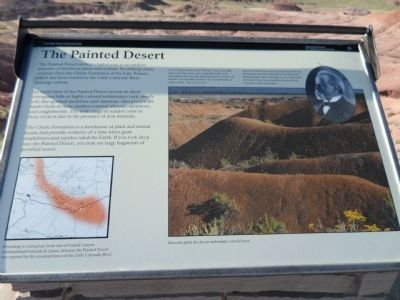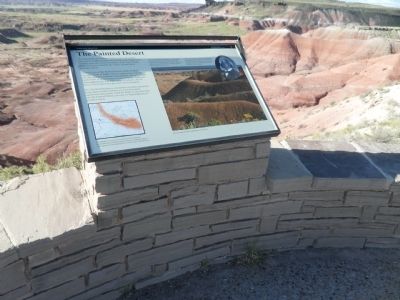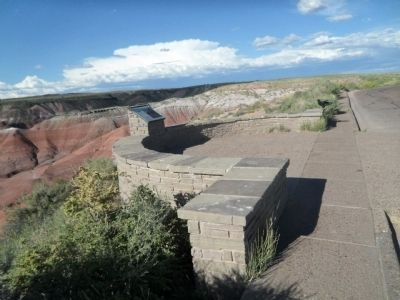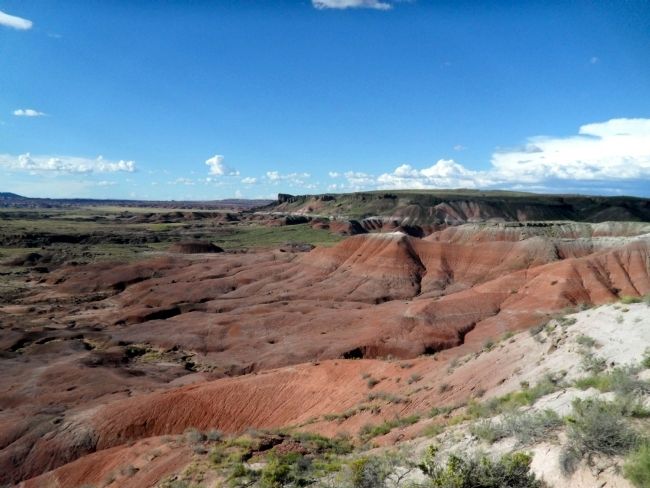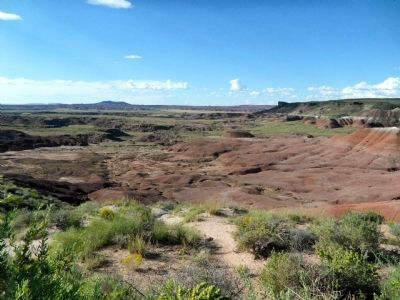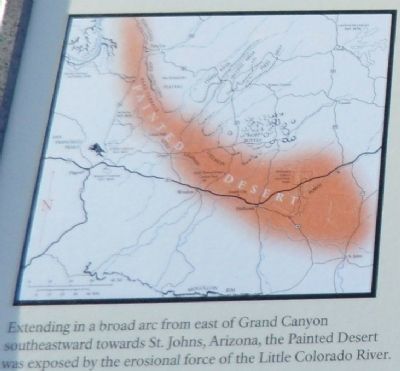Holbrook in Navajo County, Arizona — The American Mountains (Southwest)
The Painted Desert
An aerial view of the Painted Desert reveals tie-dyed corrugated hills of highly colored sedimentary rock, mostly soft, fine-grained mudstone and claystone. Also present are harder beds of more somber-colored siltstone, sandstone, and conglomerate. The wide range of reddish color in these rocks is due to the presence of iron minerals.
The Chinle Formation is a storehouse of plant and animal fossils that provided evidence of a time when giant amphibians and reptiles ruled the Earth. If you look deep into the Painted Desert, you may see large fragments of petrified wood.
Erected by Petrified National Forest Services.
Topics. This historical marker is listed in these topic lists: Natural Features • Notable Places.
Location. 35° 3.785′ N, 109° 48.159′ W. Marker is in Holbrook, Arizona, in Navajo County. Marker can be reached from Petrified Forest Road, on the left when traveling north. Touch for map. Marker is in this post office area: Holbrook AZ 86025, United States of America. Touch for directions.
Other nearby markers. At least 8 other markers are within 2 miles of this marker, measured as the crow flies. Early Explorers (approx. 0.4 miles away); A Gap in the Geologic Record (approx. 0.6 miles away); Highway of Dreams (approx. 0.8 miles away); Painted Desert Community Complex Historic District (approx. 1.2 miles away); Desert Vistas (approx. 1.3 miles away); A Painted Park (approx. 1.4 miles away); Painted Desert Inn (approx. 1.6 miles away); Over the Edge (approx. 1.6 miles away). Touch for a list and map of all markers in Holbrook.
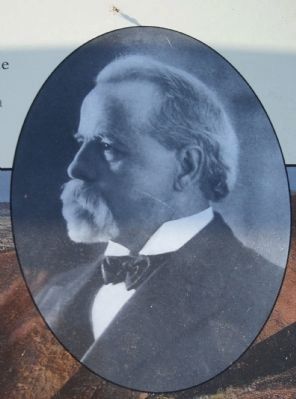
Photographed By Denise Boose, September 2, 2013
7. Iowa Congressman John Fletcher Lacey
Top Photo Caption:
Iowa Congressman John Fletcher Lacey strongly advocated the protection of public lands. The Antiquities Act of 1906, which protects “objects of historic or scientific interest” on federal lands, is often called “The Lacey Act.”
One of the first areas to be protected under the Antiquities Act was Petrified Forest National Monument in 1906. Fittingly, Lacey Point with its broad vistas was named in honor of this visionary conservationist.
Iowa Congressman John Fletcher Lacey strongly advocated the protection of public lands. The Antiquities Act of 1906, which protects “objects of historic or scientific interest” on federal lands, is often called “The Lacey Act.”
One of the first areas to be protected under the Antiquities Act was Petrified Forest National Monument in 1906. Fittingly, Lacey Point with its broad vistas was named in honor of this visionary conservationist.
Credits. This page was last revised on June 16, 2016. It was originally submitted on September 29, 2013, by Denise Boose of Tehachapi, California. This page has been viewed 670 times since then and 30 times this year. Photos: 1, 2, 3, 4, 5, 6, 7. submitted on September 29, 2013, by Denise Boose of Tehachapi, California. • Syd Whittle was the editor who published this page.
